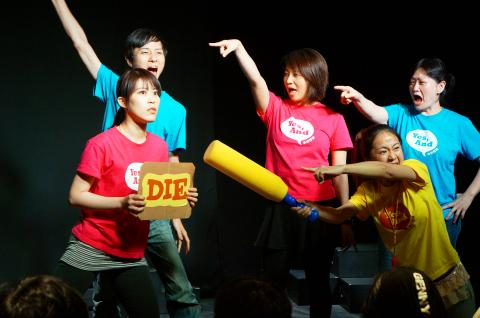Two opposing teams take the stage, ready to compete. A player from one team steps forward, seeking suggestions from the audience for a scene in which a death is involved.
“I hear mental hospital. I hear sex scene. Okay, I will take the mental hospital,” the player says, and proceeds, along with her team to create a 60-second show, which draws considerable laughter from the full-house audience. They won the round.
It was one of the several improvisational skits performed by actors from the Guts Improv Theater (勇氣即興劇場) last Friday at the company’s newly opened theater. This type of performance is called Theatersports, an invention of Keith Johnstone, a British pioneer of improvisational theater, which combines the format of a competition with theatrical performance.

Photo courtesy of Guts Improv Theater
There are several ground rules: no props and costume. Players need to make up stuff and create scenes spontaneously based on audience suggestions. There are also rules for each improvisational game. For example, one of the games played last Friday saw the players weaving together a story using disconnected lines suggested by the audience, including “come here, you,” “these problems are not real problems” and “under the banyan tree by the road.”
Like a sports game, audience engagement is also highly valued. Ways to participate include rating performances by clapping or yelling “die” to eliminate a stammering player from a game that involves members taking turn to compose a story by adding sentences.
“When I first encountered theatersports, I thought it was great fun and it challenged my theater experience. You see a group of actors on stage trying so hard to connect with those in the audience. It is spontaneous and amusing,” says Wu Hsiao-hsien (吳效賢), founder of Guts Improv Theater, which is a member of the International Theatersports Institute and holds a license to produce games of theatersports.
Setting up the company in 2004 shortly after returning to Taipei from her internship at BATS Improv, a center for improvisational theater based in San Francisco, Wu held workshops to teach improv skills before producing the troupe’s debut show in 2006. One reason is that improv theater is a little-known genre in Taiwan. Even trained actors need to learn the skills of improvisation.
“Given a prepared script, character and direction, an actor’s main responsibility is to act accordingly; on the other hand, as improvisers, our job is to act, direct and script at the same time. And we must create the characters, dialogue, action and the story collaboratively with other improvisers on stage,” Wu explains.
For Wu, improv is a form of theater that reflects life itself, unpredictable, ever-changing and without a script; its guiding principles can easily go beyond the circle of performing art and into everyday life.
“In Taiwan’s education, there is little emphasis on team work. We take tests and are taught that results are what matter. We don’t do well when it comes to helping each other out. At workshops, we use various improv games and training to emphasize processes during which failures are treated as new possibilities. It is about accepting, supporting and relying on each other. To me, it is a wonderful thing,” she says.
Apart from theatersports performance, the troupe also produces improvisational musicals as well as short-form and long-form works of improvisation. For those interested in learning improvisation, various types of workshops are on offer on a regular basis. More information can be obtained at the company‘s Web site at www.gutsimprov.com.

Oct. 27 to Nov. 2 Over a breakfast of soymilk and fried dough costing less than NT$400, seven officials and engineers agreed on a NT$400 million plan — unaware that it would mark the beginning of Taiwan’s semiconductor empire. It was a cold February morning in 1974. Gathered at the unassuming shop were Economics minister Sun Yun-hsuan (孫運璿), director-general of Transportation and Communications Kao Yu-shu (高玉樹), Industrial Technology Research Institute (ITRI) president Wang Chao-chen (王兆振), Telecommunications Laboratories director Kang Pao-huang (康寶煌), Executive Yuan secretary-general Fei Hua (費驊), director-general of Telecommunications Fang Hsien-chi (方賢齊) and Radio Corporation of America (RCA) Laboratories director Pan

The classic warmth of a good old-fashioned izakaya beckons you in, all cozy nooks and dark wood finishes, as tables order a third round and waiters sling tapas-sized bites and assorted — sometimes unidentifiable — skewered meats. But there’s a romantic hush about this Ximending (西門町) hotspot, with cocktails savored, plating elegant and never rushed and daters and diners lit by candlelight and chandelier. Each chair is mismatched and the assorted tables appear to be the fanciest picks from a nearby flea market. A naked sewing mannequin stands in a dimly lit corner, adorned with antique mirrors and draped foliage
The consensus on the Chinese Nationalist Party (KMT) chair race is that Cheng Li-wun (鄭麗文) ran a populist, ideological back-to-basics campaign and soundly defeated former Taipei mayor Hau Lung-bin (郝龍斌), the candidate backed by the big institutional players. Cheng tapped into a wave of popular enthusiasm within the KMT, while the institutional players’ get-out-the-vote abilities fell flat, suggesting their power has weakened significantly. Yet, a closer look at the race paints a more complicated picture, raising questions about some analysts’ conclusions, including my own. TURNOUT Here is a surprising statistic: Turnout was 130,678, or 39.46 percent of the 331,145 eligible party

The election of Cheng Li-wun (鄭麗文) as chair of the Chinese Nationalist Party (KMT) marked a triumphant return of pride in the “Chinese” in the party name. Cheng wants Taiwanese to be proud to call themselves Chinese again. The unambiguous winner was a return to the KMT ideology that formed in the early 2000s under then chairman Lien Chan (連戰) and president Ma Ying-jeou (馬英九) put into practice as far as he could, until ultimately thwarted by hundreds of thousands of protestors thronging the streets in what became known as the Sunflower movement in 2014. Cheng is an unambiguous Chinese ethnonationalist,